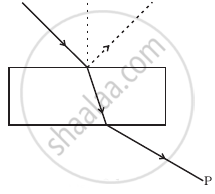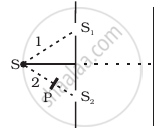Advertisements
Advertisements
Questions
What is the difference between polarised light and unpolarised light?
Differentiate between polarised and unpolarised light.
Solution
| S.No. | Polarised light | Unpolarised light |
| 1. | Consists of waves having their electric field vibrations in a single plane normal to the direction of ray. | Consists of waves having their electric field vibrations equally distributed in all directions normal to the direction of ray. |
| 2. | Asymmetrical about the ray direction | Symmetrical about the ray direction |
| 3. | It is obtained from unpolarised light with the help of polarisers | Produced by conventional light sources. |
APPEARS IN
RELATED QUESTIONS
For a glass plate as a polariser with refractive index 1.633, calculate the angle of incidence at which light is polarised.
If the critical angle of a medium is sin-1(3/5), find the polarising angle.
Show, using a simple polaroid, that light waves are transverse in nature. Intensity of light coming out of a polaroid does not change irrespective of the orientation of the pass axis of the polaroid. Explain why.
Why does an unpolarised light incident on a polaroid get linearly polarised ?
How does one demonstrate, using a suitable diagram, that unpolarised light when passed through a Polaroid gets polarised?
A beam of unpolarised light is incident on a glass-air interface. Show, using a suitable ray diagram, that light reflected from the interface is totally polarised, when μ = tan iB, where μ is the refractive index of glass with respect to air and iB is the Brewster's angle.
Two polaroids P1 and P2 are placed with their pass axes perpendicular to each other. An unpolarised light of intensity I0 is incident on P1. A third polaroid P3 is kept in between P1 and P2 such that its pass axis makes an angle of 30° with that of P1. Determine the intensity of light transmitted through P1, P2 and P3
Show, via a suitable diagram, how unpolarised light can be polarised by reflection.
When a low flying aircraft passes overhead, we sometimes notice a slight shaking of the picture on our TV screen. Suggest a possible explanation.
The refractive indices of water for red and violet colours are 1.325 and 1.334 respectively.
Find the difference between the velocities of rays for these two colours in water. (c = 3 × 108 m/s)
The glass plate of refractive index 1.732 is to be used as a polarizer, its polarising angle is _______.
With the help of an experiment, state how will you identify whether a given beam of light is polarised or unpolarized?
Green light is incident at the polarising angle on a certain transparent medium. The angle of refraction is 30° . Find
(i) polarising angle, and
(ii) refractive index of the medium.
Greenlight is an incident at the polarising angle on a certain transparent medium. The angle of refraction is 30°.
Find
(i) polarising angle, and
(ii) refractive index of the medium.
What is a analyser?
What is plane polarised light?
What is partially polarised light?
State and obtain Malus’ law.
What is the angle of polarisation and obtain the equation for an angle of polarisation?
What is double refraction?
Mention the types of optically active crystals with example.
How is polarisation of light obtained by scattering of light?
An unpolarised light of intensity 32 Wm-2 passes through three Polaroids such that the axes of the first and the last Polaroids are at 90°. What is the angle between the axes of the first and middle Polaroids so that the emerging light has an intensity of only 3 Wm-2?
A plane mirror produces a magnification of
Consider a light beam incident from air to a glass slab at Brewster’s angle as shown in figure. A polaroid is placed in the path of the emergent ray at point P and rotated about an axis passing through the centre and perpendicular to the plane of the polaroid.

Can reflection result in plane polarised light if the light is incident on the interface from the side with higher refractive index?
For the same objective, find the ratio of the least separation between two points to be distinguished by a microscope for light of 5000 Å and electrons accelerated through 100 V used as the illuminating substance.
Figure shown a two slit arrangement with a source which emits unpolarised light. P is a polariser with axis whose direction is not given. If I0 is the intensity of the principal maxima when no polariser is present, calculate in the present case, the intensity of the principal maxima as well as of the first minima.

To ensure almost 100 per cent transmissivity, photographic lenses are often coated with a thin layer of dielectric material. The refractive index of this material is intermediated between that of air and glass (which makes the optical element of the lens). A typically used dielectric film is MgF2 (n = 1.38). What should the thickness of the film be so that at the center of the visible spectrum (5500 Å) there is maximum transmission.
